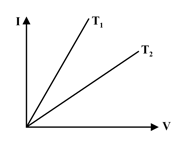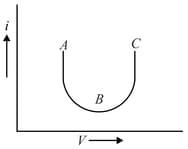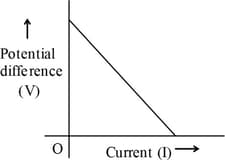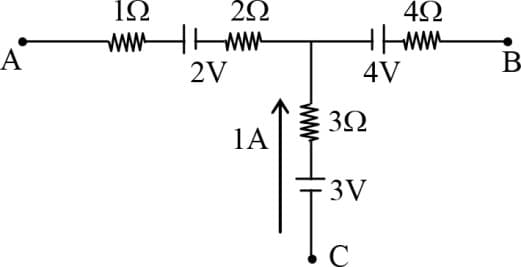Ohm's Law
Ohm's Law: Overview
This topic covers concepts, such as, Bulb Filaments, Ohm's Law, Ohmic Material and Non Ohmic Material & I-V Curve for Filament etc.
Important Questions on Ohm's Law
A wire of resistance is gradually stretched to double its original length. It is then cut into two equal parts. These parts are then connected in parallel across a battery. Find the current drawn from the battery.
A voltage of is applied across a carbon resistor with first, second and third rings of blue, black and yellow colours respectively. Calculate the value of current, in , through the resistor.
Give comment on the IV curve of the filament at high and low voltage curve.
In the figure the potential difference across resistor is . Then the potential difference between and is

A bulb used in car Headlamps is marked . Calculate the current (in amperes) flowing through it when lit?
In the following diagram current in the resistor is (when the internal resistance of the battery is zero) :-

The voltage current graph of conductor at two different temperature are shown in the Figure. If the resistances corresponding to these temperatures are and then which of the following statements is true.

A battery is connected to the terminals of a long wire of uniform thickness and resistance of The difference of potential between two points on the wire separated by a distance of will be
The potential difference between the points and as shown in the figure is

A voltmeter of resistance is connected across a cell of emf and internal resistance The potential difference across the voltmeter is
A PN junction is designed to withstand current up to a maximum of . A resistor is connected in series with it. When forward biased the diode has a potential drop of . The maximum voltage of the battery required to forward bias the diode is
A cell of emf is connected across a resistance The potential difference between the terminals of the cell is found to be The internal resistance of the cell must be
A wire of length is connected to a cell of emf and negligible internal resistance. The resistance of the wire is the additional resistance required to produce a potential difference of is
The current-voltage graph for a device is shown in figure. The resistance is negative in region.

Two similar cells, whether joined in series or in parallel, have the same current through an external resistance of . The internal resistance of each cell is .................
A potential difference is established across an electrolytic solution. It is found that divalent positive ions move towards cathode per second and monovalent negative ions move towards the anode per second. The resistance of the electrolytic solution is:
A cell of emf and internal resistance is put across a variable resistor of zero to . are potential difference and current through variable resistor. The VI curve indicates that

Consider the circuit containing resistors and an ideal battery. Potential difference is equal to (where points and are as shown in the figure)


